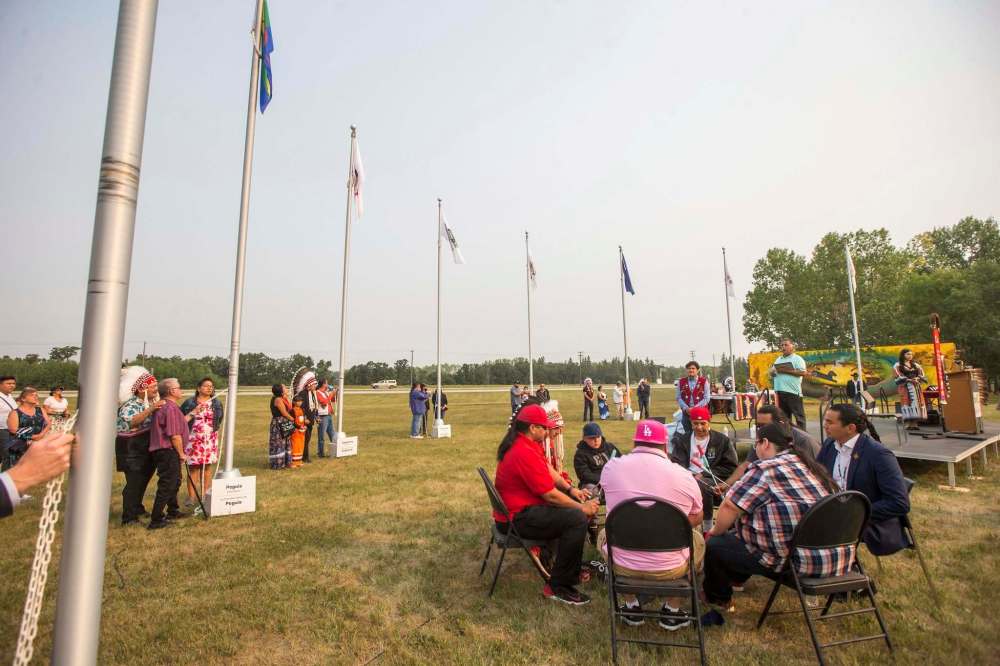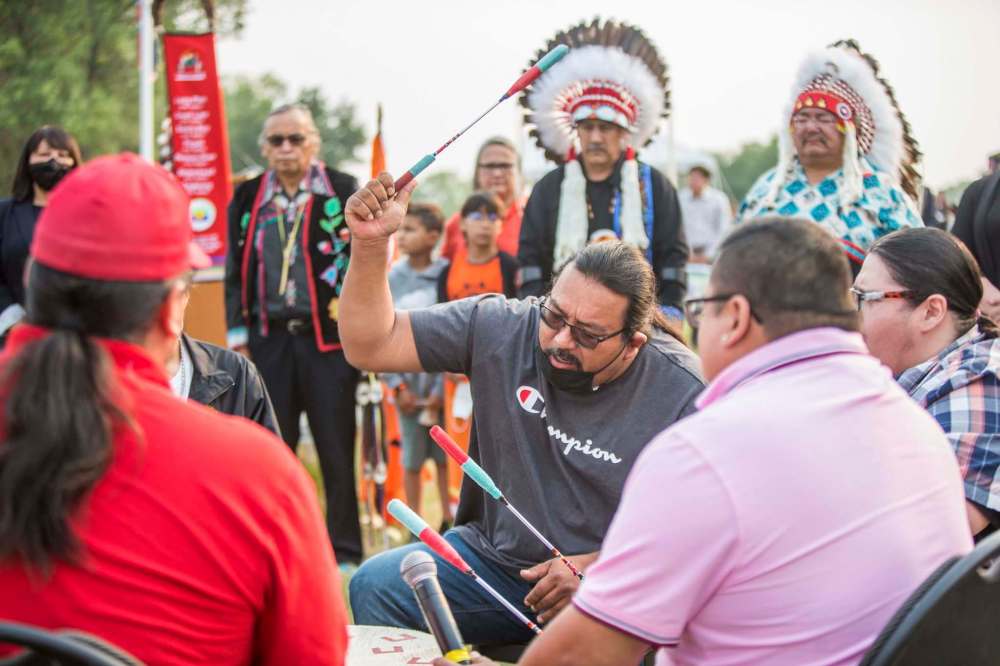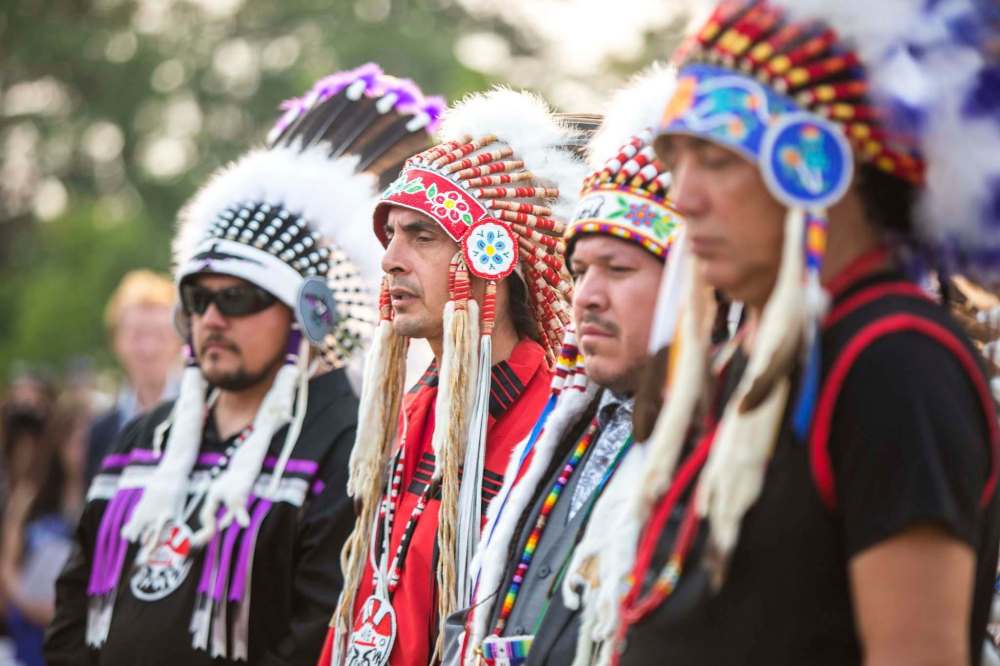Sesquicentennial of Treaty No. 1 signing honoured
Advertisement
Read this article for free:
or
Already have an account? Log in here »
To continue reading, please subscribe:
Monthly Digital Subscription
$19 $0 for the first 4 weeks*
- Enjoy unlimited reading on winnipegfreepress.com
- Read the E-Edition, our digital replica newspaper
- Access News Break, our award-winning app
- Play interactive puzzles
*No charge for 4 weeks then billed as $19 every four weeks (new subscribers and qualified returning subscribers only). Cancel anytime.
Read unlimited articles for free today:
or
Already have an account? Log in here »
Hey there, time traveller!
This article was published 02/08/2021 (1143 days ago), so information in it may no longer be current.
Drum beats, messages of a better future and calls for change rang through the air Tuesday at Lower Fort Garry to mark the 150th anniversary of Treaty No. 1.
Representatives from the seven Treaty 1 First Nations, Treaty Relations Commission of Manitoba, Canadian government officials, and treaty allies gathered at the historic site in Winnipeg.
“I think there is a true sense of hope,” said Arlen Dumas, grand chief of the Assembly of Manitoba Chiefs.

Leaders spoke at an outdoor stage surrounded by nine flags: seven representing the First Nations involved with Treaty No. 1 (Peguis, Sagkeeng, Brokenhead, Roseau River, Long Plain, Sandy Bay and Swan Lake), Canada’s flag, and the Union Jack of the United Kingdom.
The flags were lowered to half-mast in remembrance of those buried in unmarked graves near residential schools across Canada. More than 1,000 such potential individual gravesites have been discovered since May.
“I think that the finding of those unmarked graves truly highlighted the inconsistencies in what people have learned about our relationship,” Dumas said. “I feel that there’s a genuine willingness to try and do things differently.”
Indigenous people have been instrumental, from helping colonists to fighting for Canada in wars to mobilizing and providing aid during the COVID-19 pandemic, Dumas said.
“People are receptive today, and we need to realize that in order to succeed, we need strong First Nations.”

Expediting land arrangements and eliminating systemic racism are top priorities in furthering reconciliation, he added.
“Canadians are waking up,” Long Plain First Nation Chief Dennis Meeches told the crowd at Tuesday’s event.
Even so, “Canada needs to do better,” he said.
Meeches called for the former Kapyong barracks land in Winnipeg — which Treaty 1 nations will redevelop — to be granted reserve status. He and other speakers highlighted a need for environmental stewardship, among other issues.
“There’s a lot of work to do, a lot of reconciliation that’s on the table for Anishinaabe people,” Meeches said. “We need to continue down that path.”

Marc Miller, federal minister of Indigenous services, said Ottawa’s response in the Kapyong barracks sale hasn’t been quick and he’d like to move more “aggressively.”
Another focus is building schools for First Nations and letting them have autonomy, Miller said. “We’ve tried the opposite in the past, and it’s resulted in a disastrous residential school system that has broken up family units and killed people.”
Ottawa doesn’t have all the answers, nor should it impose on First Nations in issues such as choosing where to investigate for potential unmarked graves, Miller said.
“What we hear loud and clear is not for us to disappear but to be there as a partner and advocate,” he said.
Edith Clarke of Peguis First Nation thanked Miller for acknowledging First Nations’ suffering. Clarke said she has hope for her grandchildren’s futures, including access to quality education.

“The way it is right now, it’s so dismal,” said Clarke, 72. “The future for a young person is dismal… What this (talk of reconciliation) means today is change, a change for the better.”
Meanwhile, Cecil James of Roseau River Anishinaabe First Nation was wary Canada will meet all its current promises.
“It’s mixed emotions,” he said of recognizing the sesquicentennial of Treaty No. 1’s signing with the Crown on Aug. 3, 1871. “We celebrate our commitment to it.”
Parks Canada unveiled a Treaty No. 1 mural at the site in vivid blue, green and yellow. Horses, pipes and two arms clasping one another are incorporated in the design.
Lower Fort Garry also showcased its newest structures: two birch bark wigwams and a teepee Indigenous builders from Roseau River created. The fort’s exhibit included a replica of Treaty No. 1.

Treaty No. 1 was the first of 11 numbered treaties signed between 1871 and 1921 in Canada. The documents are meant to guide relations between Indigenous people and the Crown.

Gabrielle Piché
Reporter
Gabby is a big fan of people, writing and learning. She graduated from Red River College’s Creative Communications program in the spring of 2020.
Our newsroom depends on a growing audience of readers to power our journalism. If you are not a paid reader, please consider becoming a subscriber.
Our newsroom depends on its audience of readers to power our journalism. Thank you for your support.
History
Updated on Tuesday, August 3, 2021 11:21 AM CDT: Adds photo
Updated on Wednesday, August 4, 2021 6:16 AM CDT: Updates with full writethrough, adds photo






